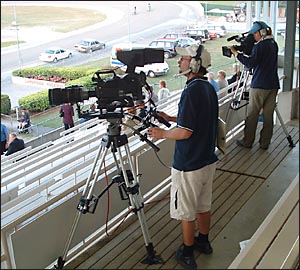The OB Camera Operator

The role of OB camera operator is a fairly specialized position. Although any competent camera operator should be able to fulfil this position without too much difficulty, there are some things to be aware of if you are considering moving into this field.
We will assume that you are already comfortable with basic camera operations and know how outside broadcasts work — this page deals specifically with the OB camera operator's position.
How the Cameras Fit Together
Being a camera operator in an OB crew is similar to working in a studio environment. Obviously the location varies and outside work has certain complications, but the basic principles are the same.
Most OB cameras are linked to a mobile control room (via cable or wireless transmitter) and mixed into the program in real time. Some cameras may not be connected directly to the main mix, instead being recorded on their own tape or disk — these recordings would be brought into the mix at a later time.
Note: Any camera which is recorded separately from the main mix is called an "iso-record" (isolated record).
Required Skills
To work well in an OB environment you will need to:
- Understand how the program is put together and how your camera shot fits into the program.
- Be able to take instructions well, and respond quickly and accurately.
- Be a good team player. Everything you do, from setting up the equipment to choosing your shots, is all part of a team effort.
- Know your left from your right! If the director tells you to pan left and you pan right you will be unpopular.
- Be confident and decisive. Although you will usually take directions for your shots you will also need to make some shot decisions on the fly. When your shots are going live to air you don't have time to stop and think about what you're going to do — it has to be second nature.
Camera Operator Duties
Everyone in the OB team needs to be aware of both their responsibilities and their boundaries. You don't want to overlook any job that you were supposed to do, but you also don't want to be so eager that you encroach on someone else's territory (some people get upset if unauthorised staff touch "their" equipment).
OB camera operators are usually involved in setting up and packing down the equipment (rigging and de-rigging). Large operations may have separate rigging staff but in most cases operators are required to assist. Depending on the situation this may include setting up cameras and platforms, running cables, erecting mobile presentation areas, setting up transmission links, etc.
During the program each operator will have certain shot requirements. Typically, each camera will be in the best position to get "their" shot and that shot will be their main focus. For example, a soccer OB will have at least two cameras in the grandstand at the halfway mark — one will keep a wide shot while the other gets the tight shots. There will also be cameras which concentrate on the goals, sidelines, etc. In some cases there will be very specialized cameras such as a wide shot from an overhead blimp, or a static camera in the dressing room.
In addition, the director might ask camera operators for extra shots such as crowd shots, etc.
Communications
Live camera operators must be able to hear instructions from the director. Camera operators usually wear a headset with an open line from the director, so they hear everything the director says to all cameras.
Camera operators can usually talk back to the director as well. In most cases the communication is mostly one-way (director to operator), but depending on the situation, the camera operator may provide occasional information back the other way. As a rule, communication from operators should be sparse and brief.
In larger OBs there may be additional communication channels. For example, camera operators might have a separate comms channel with the CCU operators or technical director.
Breaking into Outside Broadcast Work
One good thing about OB work is that there are many jobs requiring different levels of competency, meaning that there are often low-level jobs suitable for people with less experience. OBs can require riggers, cable-pullers, runners and various assistants. Also, some camera positions are difficult and reserved for the best staff, but others are so easy that good staff get bored with them and prefer to leave them for junior staff.
As always, getting a foot in the door is the most difficult and important step. If you can find a low-level position to get started with, you're on your way. See our employment section for more general information about finding work in television production.